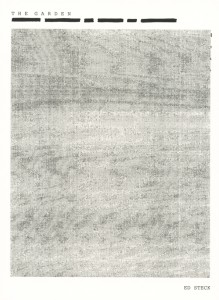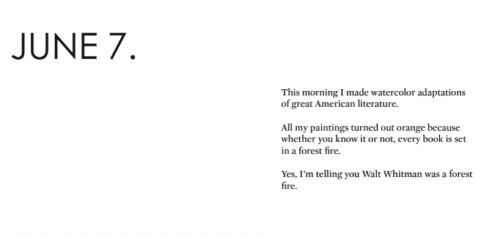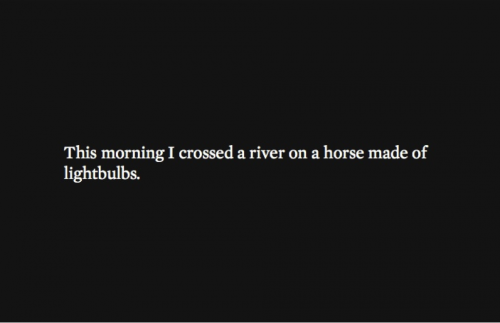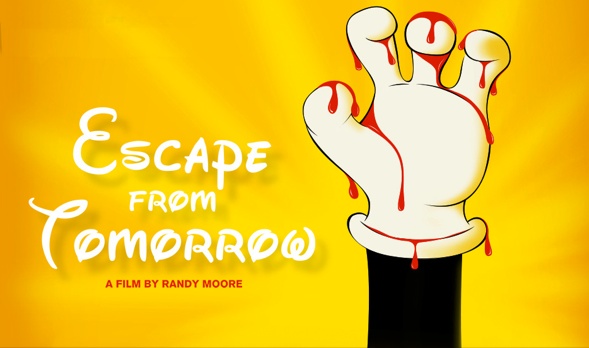Lucas de Lima’s Wet Land
 Wet Land
Wet Land
by Lucas de Lima
Action Books, March 2014
108 pages / $12-16 Buy from Action Books or SPD
The premise of Wet Land is almost impossibly weird: it’s a book-length response to the death of Lucas de Lima’s close friend Ana Maria, who was killed by an alligator. Written mostly in all-caps, the poems are delivered by a narrator who frequently takes the form of a bird, ruminating on Ana Maria, the gator, and the act of writing itself. Early on in the collection, de Lima describes the act of watching a televised reenactment of Ana Maria’s death: “IN THE NATIONAL GEOGRAPHIC DOCUMENTARY THE ACTRESS LOOKS/NOTHING LIKE ANA MARIA;/THE OTHER ACTRESS LOOKS NOTHING LIKE HER FRIEND.” Here, de Lima sets the tone for many of the tensions that characterize this collection. It’s easy to criticize this kind of tasteless reenactment—to see it as a byproduct of a violent, media-obsessed culture. But in Wet Land, de Lima turns the lens on himself, exploring his own anxiety about being complicit in the reappropriation of tragedy.
June 23rd, 2014 / 10:00 am
Inclusion in Ed Steck’s The Garden
 The Garden
The Garden
by Ed Steck
Ugly Duckling Presse, 2013
104 pages / $14 Buy from UDP
If the Romantic model of the garden is cultivation, then the Post-War model is invasion. Robert Duncan inquires of that famous, primordial garden, “is it dream or memory? homeland of the pleasure principle in the libidinal sea, an island girt round with forbidding walls?”[1] And of ornamentation, William Carlos Williams reminds us “that the bomb also is a flower.”[2] The multiflorous gardens of Ronald Johnson abstract whole histories for admission into their horticultural field. Rampancy, tended by besieged consciousnesses, overruns “the old garden-ground of boyish days.”[3]
The degradation of idealized forms is, of course, a hallmark of post-modernism, but the temptation of placing the world within the garden, or enlarging one’s garden infinitely, enacts a dialogue of control and ownership that becomes problematic for any anti-imperialistic project. Similarly, there is the risk of oversimplification that an artist runs when attempting to account for the volume of media produced around the event of war. Ed Steck’s The Garden: Synthetic Environment for Analysis and Simulation, published by Ugly Duckling Presse, continues the erosion of privileged space begun midcentury with an all-important newness equipped to navigate the bizarre landscape of the 21st.
June 23rd, 2014 / 10:00 am
Whas’Poppin: 6/20/14

All weekend I was in New York, which is like AWP all the time (((minus the one time they had turkey legs ((although I’m sure if you put your mind to it you can find a turkey leg in New York (although maybe not because that seems to be a “country” fair type thing and believe it or not I didn’t see a damn deer until I was 18 years old so what do I know)))))). I got back to DC on Sunday and at work on Monday I gchatted Mike and I says “Sucks, dunnit” and he says “wha” and I says “not being there” and he says “TRU.” Which was a little confusing, since it wasn’t really that memorable of a weekend, but then I saw that Lauren Russell interviewed Dana Ward at Hot Metal Bridge and Dana said:
“I can’t imagine writing, or thinking at all, without doing so somehow with others, especially those friends permissive enough to co-create, & then perpetuate, a space where its ok to fuck things up by writing stuff that might say really really stupid shit, change each other’s minds, & then still be around no matter, going on doing writing, not writing at all, keeping up with one another out of need & love, for the specific forms that people make, so doing.”
And then at that point the cab rides and the dad shirts and boxing gloves made a little more sense.
——–—
I.
Before I begin to say what will be the thing that will be the first
thing you hear today, let it be known: we are all in distress.
Erin J Mullikin, “Naked On The Internet” (Alice Blue Review*)
II.
Every day I exercise and I tone and I skinny myself into a spectacular hell
Natalie Eilbert, “Freaky Friday” (at COVEN, Brooklyn, NY)
III.
& ask again & my uncle out in the field with the spade & my uncle out in the ditch with the spade & I went into the lake & thought about the farm & I went into the lake & made my will & all of the farm to my brother & my sister in the house & my father in the ditch of his fields & the goats up in the mountain struggling with the grass.
Lisa Ciccarello, “I only thought of the farm” (The Volta)
IV.
I have gotten good and high, you see.
And I do sometimes try
to be at least
a little pretty.
Joshua Kleinberg, “Yorick” (Spork)
V.
I could cry at anyone’s home movies.
Bruised haircuts, inflatable pools—
I would score them all in B minor.
-Kathy Goodkin, “Ancient of Days” (Dreginald)
———-
xxx
*K, so that’s the link to the poem and doing that removes the nav frame. Here’s the link the whole issue but that link isn’t going to work forever, because it’s just a link to the main page and one day it’s gonna have a completely different issue, so if you’re reading this in 2039 and you can’t find this poem, give me a call and we can find it together.
The Inevitable June by Bob Schofield
 The Inevitable June
The Inevitable June
by Bob Schofield
theNewerYork Press, June 2014
144 pages / $20 Buy from theNewerYork
I think a lot about the color orange, and also about new ways of naming.

From The Inevitable June. Image courtesy of biblioklept.
Frank O’Hara thinks about orange one day. He writes pages and pages of poetry. He says in Why I am Not a Painter that “There should be / so much more, not of orange, of / words, of how terrible orange is / and life.”

From The Inevitable June. Image courtesy of theNewerYork.
Both Schofield and O’Hara seem correct about orange. But, as his relationship to orange is meant to show, O’Hara is not a painter. Whatever you want to call The Inevitable June in terms of genre (who cares?), it’s heavy on the visual, so orange for Schofield and his narrator doesn’t serve as a line in the sand, stifling or sidestepping the visual. Instead, orange is simply something discovered to be inevitable, much like the inevitability of the old woman who kisses the narrator on the cheek on June 6. Even as ‘every book’ might not seem orange, adapting any given book to watercolor will ‘reveal’ its inevitable orangeness.
This is important, I feel: the indeterminacy or withdrawnness of Schofield’s language is anchored to the irrevocability of the narrative arc. What happens in it is what happens, both contingent and unavoidable, and the language coils around this anchor in something resembling play, or discovery, but not of anything. More a disembodied feeling whose color the reader inevitably wants to name. The visual element also explores this tension, serving both as a clean, minimal ground for the flight of imagery as well as sometimes ‘phasing’ into inscrutability with respect to its relation to the words.

from The Inevitable June. Image courtesy of biblioklept.
June 20th, 2014 / 10:00 am
A “Baseball” Interview with Josh Ostergaard
 Last night the Kansas City Royals won their tenth game in a row, which should make my friend Josh Ostergaard pretty happy. He’s a Royals fan from way back, and that comes out in his new book from Coffee House Press, The Devil’s Snake Curve. The 256-page alternative history book is made of five chapters with titles you might not expect to find in a baseball book, such as “War” and “Nationalism.” These chapters are broken up into short sections, which also have titles. The first is “Kansas” and the last is “On the Beach” and along the way there are hundreds more, like “Cud,” “The Value of a Soldiers Life,” and “Another Take on Hair.”
Last night the Kansas City Royals won their tenth game in a row, which should make my friend Josh Ostergaard pretty happy. He’s a Royals fan from way back, and that comes out in his new book from Coffee House Press, The Devil’s Snake Curve. The 256-page alternative history book is made of five chapters with titles you might not expect to find in a baseball book, such as “War” and “Nationalism.” These chapters are broken up into short sections, which also have titles. The first is “Kansas” and the last is “On the Beach” and along the way there are hundreds more, like “Cud,” “The Value of a Soldiers Life,” and “Another Take on Hair.”
These nonlinear sections weave through numerous subjects, sometimes about the roots of baseball and baseball traditions, sometimes about the strange cast of players and owners. Josh also writes funny anecdotes about his own experiences playing the sport, and the socio-political incidences that have occurred related to the game both in the US and around the world. War comes up a lot, and not just in reference to Abner Doubleday playing rounders in 1861 (or whatever). This is a serious book, heavily researched, and complicated. In fact, referencing the Royals’ current success is misleading, given how little attention Josh pays to the scoreboard compared to the game as cultural soporific or propaganda machine.
It’s interesting how many ways the book is characterized. Publishers Weekly listed it in its Top 10 for sports books while Shelf Awareness called it “a backdrop for American political history.” Epoch Times said it’s “a kind of Fargo of baseball books” (?). I like Eula Biss’s comment, who said it’s “like a box of eclectic baseball cards about our country and our culture—curious, compelling, and disturbing in turn.”
You worked on this for years and years, right?
I started writing in late 2004. I remember flying to Amsterdam that Christmas to visit my sister and taking on the plane a pile of old newspaper clippings about Lew Burdette, the Braves pitcher who was good at beating the Yankees. But I think the genesis of The Devil’s Snake Curve was the year before, during the months leading to the Iraq war. Like millions of other people I was against what was clearly a war of choice in Iraq, and even in the New York Times there was enough doubt about WMD and about the lack of connection between Iraq and 9/11 that it was obvious our country was about to go off the rails. During those very same months, The Field Museum, where I worked, hosted an exhibition called “Baseball as America.” I went through the exhibit many times, and enjoyed it, but the more I thought about it, the less I was able to reconcile the mythology of the sport and of our nation with the incessant warmongering. Then we started bombing Baghdad. The Devil’s Snake Curve is my attempt to reconcile the darker aspects of American history with the ways professional baseball has been represented. That old cliché about the Black Sox—“say it ain’t so”—well, that’s how I feel, but with regard to the ways the sport has been used as a public relations vehicle for war during the past decade.
MEGALOMANIA VOL I: “a beginner’s guide to elias tezapsidis”
5 ways to get elias to like you
buy him an expensive dinner, an expensive outfit, or something expensive that he would like
tell elias about yourself but don’t talk too much about yourself or elias will tune you out
never under any circumstance tell elias that he’s your second favorite person
if you call elias in the middle of the night, please have something important to say to him (i.e. elias i just bought you a super expensive outfit) or he will terminate your relationship
do not bore elias under any circumstance
jonathan franzen despises elias
jonathan franzen does not like elias for some reason. it’s probably because elias writes a lot on the internet and jonathan franzen doesn’t know how to use the internet properly
elias grew up in greece
elias was a happy child in greece. he was super popular and everyone loved him. if this is a surprise to you, then you have a lot more to learn about elias
25 Points: Escape from Tomorrow

1. This movie stuck it to the man by filming the entire production in both Disneyland and Disney World without their permission.
2. Disney is apparently “aware” of this movie but has taken no legal action.
3. I’d never heard of this film until a friend forced me to watch it. I neither regret this nor thank him for it.
4. This film somehow succeeded in making Disney a terrifying menace that is a threat to fathers everywhere.
5. “What the fuck am I watching?” is what I thought multiple times while viewing this film.
6. Pedophilia is everywhere in Disney. Fathers chase after underage French girls, retired Disney princesses kidnap little kids to reenact scenes from Snow White, little boys are shown pictures of naked foreign women during cinematic rides—the list goes on and on.
7. Can’t help but be paranoid that Disney will sue me over this review. I have nothing, you bastards.
8. The film opened with someone being decapitated on a Disney ride—then cut to a scene of a corporate asshole firing the protagonist over the phone while he was on vacation with his family. The scary part is that both of these incidents have occurred multiple times throughout the course of modern human history. This makes me dread graduating college and entering the real world.
9. My friend and I both agreed that the protagonist’s wife was a bitch the entire film. (Spoilers: she sadly doesn’t die.)
10. There’s a scene where a nurse suddenly breaks into tears and I still don’t understand why.
June 19th, 2014 / 12:00 pm
Over at The Atlantic, Ian Bogost has a fascinating essay that frames itself as a discussion of the Star Trek: TNG episode “Darmok” (more easily remembered as the “Shaka, when the walls fell” episode, or the “Darmok and Jalad at Tanagra” episode, or that episode where Picard couldn’t build a fire because he was too busy dramatically holding knives, and Troi and Data both got really dumb, and the aliens kept talking weird about all their past successes and failures) and extends itself into a discussion of language, logic, allegory, and SimCity. In other words, Ian Bogost obviously wrote an essay about poetry, whether he meant to or not, and we should all read it.
Too Much for American Poetry Circles ?? (Persona Peep Show)
(Persona Peep Show by Sara Tuss Efrik and Mark Efrik Hammarberg)
**********
Over at Montevidayo James Pate wrote the following about Persona Peep Show:
Persona Peep Show is an incredibly visceral work, and, as such, I can imagine it making some parts of the American poetry scene uncomfortable. It’s easy to imagine the standard criticisms: it’s too grotesque, too image-based, it’s too pleasurable (in a funhouse sort of way), it doesn’t properly “critique” or distance itself from XYZ. Its use of fairytale is anachronistic, and therefore conservative (God forbid we should ever disturb the laws of Hegelian-inflected historical linearity). And yet this video makes such criticisms seem old-fashioned and academic. As I’ve written about before on Montevidayo, there is a strong contemporary tradition in the art scene of masquerade, theatricality, excess, color. Jack Smith, Cindy Sherman, Matthew Barney, Ryan Trecartin. And a film like Persona Peep Show is very much related to that sensibility.
And in the comments section of that post Johannes Göransson adds:
Just the mere move of poetry into the video image is already a challenge to a US poetry which for so long has seen itself as inherently ethical precisely in opposition to the spectacularity of film, video etc.
**********
In an earlier Monteviday post–Adventures with weird rabbits and dismemberments: Sara Tuss Efrik’s deformation zone-–Göransson described Efrik’s work (written and video) as an investigation of “wound culture” and found one of her “Automanias” to be “a constant tension between the many and the singular, the diary-narrative and the forces that break apart the body.”
It’s not hard to see that “too much” dismemberment, “too much” of weird rabbits, etc, would make a conservative and old-fashioned Poetry Community uncomfortable but I’m particularly struck by Göransson’s contention that the “the mere move of poetry into the video image” would create some discomfort in the same stodgy circles that view themselves as “inherently ethical in opposition to the spectacularity of film, video etc.”
Perhaps since Art and Ethics have been on my mind a bit lately (see my recent Abramson Debacle post as well as its comment thread) I’m tickled here, particularly, by the the sense of righteousness at play. The sense of a moral superiority.
********
But are these Automanias and Videos too much for American Poetry Circles ?? Some of them ?? Most of them ??
**********
The new ACTION YES contains two more Efrik videos and you can check out some of the Automanias here in an earlier issue.

